大数据——PageRank算法
pagerank算法例子
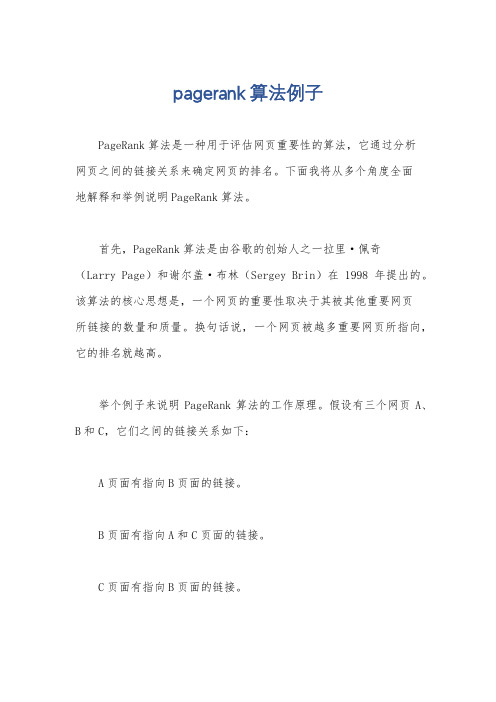
pagerank算法例子PageRank算法是一种用于评估网页重要性的算法,它通过分析网页之间的链接关系来确定网页的排名。
下面我将从多个角度全面地解释和举例说明PageRank算法。
首先,PageRank算法是由谷歌的创始人之一拉里·佩奇(Larry Page)和谢尔盖·布林(Sergey Brin)在1998年提出的。
该算法的核心思想是,一个网页的重要性取决于其被其他重要网页所链接的数量和质量。
换句话说,一个网页被越多重要网页所指向,它的排名就越高。
举个例子来说明PageRank算法的工作原理。
假设有三个网页A、B和C,它们之间的链接关系如下:A页面有指向B页面的链接。
B页面有指向A和C页面的链接。
C页面有指向B页面的链接。
根据PageRank算法,我们可以计算每个页面的初始排名。
假设初始排名为1,我们可以得到以下结果:A页面的初始排名为1。
B页面的初始排名为1。
C页面的初始排名为1。
接下来,我们根据链接关系来更新页面的排名。
根据PageRank 算法的计算公式,排名的更新是一个迭代过程。
在每一次迭代中,我们根据页面之间的链接关系来更新页面的排名。
在第一次迭代中,我们可以得到以下结果:A页面的排名更新为,1/2(来自B页面的链接)。
B页面的排名更新为,1/2(来自A页面的链接) + 1(来自C 页面的链接)。
C页面的排名更新为,1/2(来自B页面的链接)。
在第二次迭代中,我们再次根据链接关系来更新页面的排名。
根据公式,我们可以得到以下结果:A页面的排名更新为,1/2(来自B页面的链接) + 1/2(来自B页面的链接)。
B页面的排名更新为,1/2(来自A页面的链接) + 1(来自C 页面的链接)。
C页面的排名更新为,1/2(来自B页面的链接)。
通过多次迭代,我们最终可以得到每个页面的稳定排名。
在这个例子中,最终的排名结果可能是:A页面的排名为0.75。
B页面的排名为1.5。
C页面的排名为0.75。
PageRank算法在网页排序中的应用及改进

PageRank算法在网页排序中的应用及改进PageRank算法是一种在网页排序中广泛应用的算法,旨在根据页面间的链接关系和互动,为网页分配权重。
本文将介绍PageRank算法的基本原理和其在网页排序中的应用,并探讨一些改进方法,以提高其准确性和效率。
一、PageRank算法的基本原理PageRank算法是由谷歌公司的创始人之一拉里·佩奇(Larry Page)和谢尔盖·布林(Sergey Brin)于1996年提出的。
它根据网页之间的相互链接关系来计算每个网页的重要性指标,基本原理如下:1. 网页的权重:PageRank算法认为,一个网页的重要性取决于其被其他重要网页所链接的数量和质量。
一个链接来自权重高的网页对被链接的网页权重的贡献也更大。
2. 链接关系的传递性:如果网页A链接到网页B,那么网页B将获得一部分网页A的权重。
这种链接关系的传递性可以通过迭代计算来逐步传递网页的权重。
3. 反向链接的重要性:网页B被更多重要网页所链接时,网页B的权重会更高。
这个想法来源于互联网上用户通过链接表达的投票行为。
相对于单纯的链接数量,反向链接更能反映网页的权威性和受欢迎程度。
二、PageRank算法在网页排序中的应用PageRank算法在网页排序中的应用主要体现在搜索引擎中,通过计算网页的PageRank值,对搜索结果进行排序,从而提供更准确和有用的搜索结果。
1. 提高搜索准确性:PageRank算法通过对网页的重要性进行评估,将重要网页排在搜索结果的前面。
这样用户可以更容易地找到权威和有价值的信息。
2. 抑制垃圾信息:通过使用PageRank算法,搜索引擎可以过滤掉一些垃圾信息或低质量的网页。
因为这些网页往往没有被高质量网页所链接,其PageRank值较低。
3. 发现新网页:PageRank算法还可以帮助搜索引擎发现新网页。
当一个新网页被高质量网页链接时,其PageRank值将增加,并逐渐被搜索引擎所索引和优先展示。
Google三大论文(中文)

Google三大论文(中文)Google三大论文(中文)Google是世界上最大的互联网公司之一,也是许多人使用的首选搜索引擎。
Google的成功离不开他们所采用的先进技术和创新思维。
在过去的几十年里,Google发表了许多重要的研究论文,这些论文对于推动计算机科学和人工智能领域的发展起到了巨大的贡献。
本文将介绍Google三篇重要的论文,它们分别是PageRank算法、DistributedFile System和MapReduce。
一、PageRank算法PageRank算法是Google搜索引擎的核心算法之一。
这个算法是由Google的创始人之一拉里·佩奇(Larry Page)和谢尔盖·布林(Sergey Brin)于1998年提出的。
PageRank算法通过分析与网页相关的链接数量和质量来评估网页的重要性,从而确定搜索结果的排名。
PageRank算法基于图论的概念,将互联网看作一个巨大的有向图,其中每个网页都是图中的一个节点,而网页之间的链接则是图中的边。
根据这些链接的链入和链出关系,算法可以计算出每个网页的PageRank值。
具有高PageRank值的网页会在搜索结果中排名较高,从而提高网页的可见性和流量。
二、Distributed File SystemDistributed File System(分布式文件系统)是Google为解决海量数据存储和处理问题而开发的一种分布式文件系统。
该系统最早在2003年的一篇名为《The Google File System》的论文中被介绍。
这个论文由Google的工程师们撰写,并提出了一种基于分布式架构和冗余存储的文件系统设计方案。
Distributed File System的设计目标是实现高可靠性、高性能和可扩展性。
它通过将大文件切割成小块并分布式存储在多台服务器上,同时也保证了数据的冗余存储和高可靠性。
这使得用户可以快速地读取和写入大规模的数据。
pagerank算法公式

pagerank算法公式
PageRank是一种衡量网页重要性的算法,其基本思想是:对于一个网页,其“重要性”或者“权威性”主要取决于其引用的网页质量和数量。
PageRank的计算公式如下:
v’=Mv
其中,v是一个n维向量,每个分量代表对应节点的PageRank值的估计值,称作概率分布向量。
M是一个n×n矩阵,表示万维网的网页构成的图。
节
点A、B、C、D代表网页,有向边代表起点页面包含终点页面的链接。
PageRank还有一个简化模型:一个网页的影响力等于所有入链集合的页面的加权影响力之和,公式表示为:PR(u)=∑v∈BuPR(v)L(v)PR(u)=\sum_{v \in B_{u}} \frac{P R(v)}{L(v)}PR(u)=v∈Bu∑L(v)PR(v)u为待评估的页面,Bu为页面u的入链集合。
针对入链集合中的任意页面v,它能给u带来的
影响力是其自身的影响力PR(v)除以v页面的出链数量,统计所有能给u带来链接的页面v,得到的总和就是网页u的影响力,即为PR(u)。
请注意,这只是PageRank算法的简化模型,实际应用中PageRank算法会更复杂。
如需了解更多关于PageRank算法的信息,建议咨询计算机领域专业人士或查阅相关书籍。
十大经典大数据算法
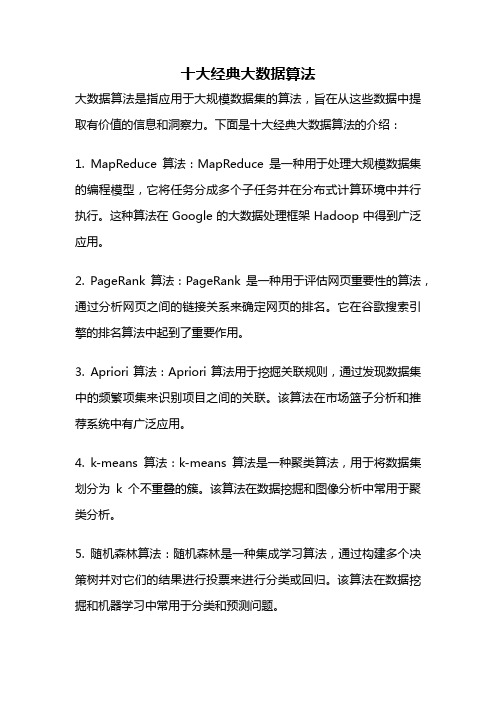
十大经典大数据算法大数据算法是指应用于大规模数据集的算法,旨在从这些数据中提取有价值的信息和洞察力。
下面是十大经典大数据算法的介绍:1. MapReduce算法:MapReduce是一种用于处理大规模数据集的编程模型,它将任务分成多个子任务并在分布式计算环境中并行执行。
这种算法在Google的大数据处理框架Hadoop中得到广泛应用。
2. PageRank算法:PageRank是一种用于评估网页重要性的算法,通过分析网页之间的链接关系来确定网页的排名。
它在谷歌搜索引擎的排名算法中起到了重要作用。
3. Apriori算法:Apriori算法用于挖掘关联规则,通过发现数据集中的频繁项集来识别项目之间的关联。
该算法在市场篮子分析和推荐系统中有广泛应用。
4. k-means算法:k-means算法是一种聚类算法,用于将数据集划分为k个不重叠的簇。
该算法在数据挖掘和图像分析中常用于聚类分析。
5. 随机森林算法:随机森林是一种集成学习算法,通过构建多个决策树并对它们的结果进行投票来进行分类或回归。
该算法在数据挖掘和机器学习中常用于分类和预测问题。
6. SVM算法:支持向量机(SVM)是一种监督学习算法,用于进行分类和回归分析。
它通过构建一个最优的超平面来将不同类别的样本分开。
7. LDA算法:潜在狄利克雷分配(LDA)是一种用于主题建模的生成模型,用于从文本数据中发现隐藏的主题结构。
该算法在自然语言处理和信息检索中有广泛应用。
8. 特征选择算法:特征选择是一种用于从数据集中选择最相关特征的方法。
常用的特征选择算法包括信息增益、卡方检验和互信息等。
9. 随机梯度下降算法:随机梯度下降是一种用于优化模型参数的迭代优化算法。
该算法通过计算损失函数的梯度来更新模型参数,从而最小化损失函数。
10. 奇异值分解算法:奇异值分解(SVD)是一种矩阵分解方法,用于降低数据维度和提取数据的主要特征。
该算法在推荐系统和图像处理中常用于降维和特征提取。
PageRank算法

PageRank算法1. PageRank算法概述PageRank,即⽹页排名,⼜称⽹页级别、Google左側排名或佩奇排名。
是Google创始⼈拉⾥·佩奇和谢尔盖·布林于1997年构建早期的搜索系统原型时提出的链接分析算法,⾃从Google在商业上获得空前的成功后,该算法也成为其他搜索引擎和学术界⼗分关注的计算模型。
眼下许多重要的链接分析算法都是在PageRank算法基础上衍⽣出来的。
PageRank是Google⽤于⽤来标识⽹页的等级/重要性的⼀种⽅法,是Google⽤来衡量⼀个站点的好坏的唯⼀标准。
在揉合了诸如Title标识和Keywords标识等全部其他因素之后,Google通过PageRank来调整结果,使那些更具“等级/重要性”的⽹页在搜索结果中另站点排名获得提升,从⽽提⾼搜索结果的相关性和质量。
其级别从0到10级,10级为满分。
PR值越⾼说明该⽹页越受欢迎(越重要)。
⽐如:⼀个PR值为1的站点表明这个站点不太具有流⾏度,⽽PR值为7到10则表明这个站点很受欢迎(或者说极其重要)。
⼀般PR值达到4,就算是⼀个不错的站点了。
Google把⾃⼰的站点的PR值定到10,这说明Google这个站点是很受欢迎的,也能够说这个站点很重要。
2. 从⼊链数量到 PageRank在PageRank提出之前,已经有研究者提出利⽤⽹页的⼊链数量来进⾏链接分析计算,这样的⼊链⽅法如果⼀个⽹页的⼊链越多,则该⽹页越重要。
早期的⾮常多搜索引擎也採纳了⼊链数量作为链接分析⽅法,对于搜索引擎效果提升也有较明显的效果。
PageRank除了考虑到⼊链数量的影响,还參考了⽹页质量因素,两者相结合获得了更好的⽹页重要性评价标准。
对于某个互联⽹⽹页A来说,该⽹页PageRank的计算基于下⾯两个基本如果:数量如果:在Web图模型中,如果⼀个页⾯节点接收到的其它⽹页指向的⼊链数量越多,那么这个页⾯越重要。
page rank算法的原理

page rank算法的原理
PageRank算法是由谷歌创始人之一拉里·佩奇(Larry Page)
提出的,用于评估网页在搜索引擎中的重要性。
PageRank算法的原理可以概括为以下几点:
1. 链接分析:PageRank算法基于链接分析的思想,认为一个
网页的重要性可以通过其被其他重要网页所链接的数量来衡量。
即一个网页的重要性取决于其他网页对它的引用和推荐。
2. 重要性传递:每个网页都被赋予一个初始的权重值,然后通过不断迭代的计算过程,将网页的重要性从被链接的网页传递到链接的网页。
具体来说,一个网页的权重值由其被其他网页所链接的数量以及这些链接网页的权重值决定。
3. 随机跳转:PageRank算法引入了随机跳转的概念。
即当用
户在浏览网页时,有一定的概率会随机跳转到其他网页,而不是通过链接跳转。
这样可以模拟用户在浏览网页时的行为,并增加所有网页的重要性。
4. 阻尼因子:PageRank算法还引入了阻尼因子,用于调控随
机跳转的概率。
阻尼因子取值范围为0到1之间,通常取值为0.85。
阻尼因子决定了用户在浏览网页时选择跳转到其他网页
的概率。
通过以上原理,PageRank算法可以计算出各个网页的重要性
得分,从而在搜索引擎中按照重要性进行排序。
PageRank算法的原理及应用

PageRank算法的原理及应用PageRank算法是一种被广泛应用于搜索引擎的网页排序算法,它是由Google公司的两位创始人——拉里·佩奇和谢尔盖·布林在1998年发明的。
经过多次改进和完善,如今的PageRank算法已经成为了搜索引擎排名的重要指标之一。
本文将从算法原理、公式推导和应用探究三个方面来介绍PageRank算法。
一、算法原理PageRank算法的核心思想是基于互联网上各个页面之间的链接关系进行排序,在一定程度上反映了网页的权威性和价值。
所谓链接关系,就是指一个页面通过超链接将访问者引向另一个页面的关系。
如果一个网页被其他网页链接得越多,那么这个网页的权威度就应该越高。
但是,PageRank并不直接以链接数量作为评价标准,而是通过一个复杂的算法来计算每个网页的等级。
具体来说,PageRank算法是基于马尔科夫过程的概率模型,它将互联网上的所有页面抽象成图形,每个网页都是一个节点,超链接则是节点之间的边。
PageRank算法的核心计算就是将这个图形转化成一个矩阵,然后使用迭代的方式求出每个节点的等级,即PageRank值。
在这个过程中,每个节点的PageRank值会受到其它所有节点的影响,而它自身的权值又会传递给其他节点,如此循环迭代,直到所有节点的PageRank值趋于收敛。
二、公式推导PageRank算法的公式推导是比较繁琐的,这里只能简单概括一下。
首先,PageRank值可以表示为一个向量,每个向量元素代表一个页面的权值。
由于PageRank算法是基于网页链接之间的关系计算出来的,所以可以将它表示成一个矩阵M,该矩阵中的元素mi,j表示第j个页面指向第i个页面的链接数量。
接着,可以构造一个向量v,v中的所有元素都是1/N(其中N为网页总数),代表每个页面初始的PageRank值。
然后,PageRank值可以通过迭代计算得到,具体的计算公式如下:PR(A) = (1-d)/N + d * (PR(T1)/C(T1) + … + PR(Tn)/C(Tn))其中,PR(A)表示节点A的PageRank值,d是一个常数(0<d<1),代表网页的阻尼系数,T1-Tn是所有指向节点A的页面,C(Ti)是Ti页面的出链总数,PR(Ti)是Ti页面的PageRank值,N为网页总数。
pagerank算法步骤

pagerank算法步骤PageRank算法是一种用于评估网页重要性的算法,是由Google的创始人拉里·佩奇和谢尔盖·布林共同提出的。
它是一种基于链接分析的算法,主要通过计算一个网页的入链数和出链数来判断其重要性。
具体的PageRank算法步骤如下:1. 初始化PageRank值:对于一个网页,初始的PageRank值一般为1/N,其中N为所有网页的总数。
将这些初始值赋予所有的网页。
2. 迭代计算:根据PageRank的计算公式进行迭代计算,直到收敛为止。
PageRank的计算公式如下:PR(A) = (1-d)/N + d * (PR(T1)/C(T1) + PR(T2)/C(T2) + ... + PR(Tn)/C(Tn))其中PR(A)为网页A的PageRank值,d为阻尼系数,一般取值为0.85,N为所有网页的总数,T1、T2、...、Tn为指向网页A的网页,C(T1)、C(T2)、...、C(Tn)分别为这些指向网页A的网页的出链数。
迭代计算每个网页的PageRank值,直到前后两次迭代值的差异小于某个预定的阈值,即达到收敛。
3. 解决网页零入链问题:在计算过程中,可能出现一些网页没有任何其他网页指向它,即零入链问题。
为解决这个问题,可以给这些网页一个初始的PageRank值,并在迭代计算中加入一个平均值部分,使得网页的重要性能够传递给零入链的网页。
以上就是PageRank算法的主要步骤。
实际应用中,还可以对阻尼系数d进行微调,以达到更好的效果。
此外,为了加快迭代计算的速度,可以采用分布式计算的方式进行计算。
参考内容:1. 《The Anatomy of a Large-Scale Hypertextual Web Search Engine》(拉里·佩奇、谢尔盖·布林):这是PageRank算法的原始论文,详细介绍了算法的思想和具体实现。
论文发表于1998年,是该算法最早的介绍。
大数据经典算法PageRank 讲解

如果按这个公式迭代算下去,会发现自连接点的问题解决了,从而每个页面 都拥有一个合理的pagerank。
分块式Pagerank算法:
火龙果整理
单击此处添加段落文字内容
原来的算法存在的问题:
1.时间开销大。每次迭代就算时间开销为
2.因特网中数据大部分是分布式的,计算过程需要多次传递数据,网 络负担太大。
火龙果整理
PageRank算法
基本PageRank 面向主题PageRank Link Spam与反作弊 导航页与权威页
一小组:王高翔,李渠,刘晴,柳永康,刘昊骋 二小组: 王飞,李天照,赵俊杰,陈超,陈瑾翊
一.Pagerank定义及终点,自连接点的概念
早期搜索引擎的弊端
火龙果整理
火龙果整理
TrustRank
TrustRank的思想很直观:如果一个页面的普通rank远高 于可信网页的topic rank,则很可能这个页面被spam了。 设一个页面普通rank为P,TrustRank为T,则定义网页的 Spam Mass为:(P – T)/P。 Spam Mass越大,说明此页面为spam目标页的可能性越 大。
为了克服这种问题,需要对PageRank 计算方法进行一个平滑处理,具体做 单击添加 法是加入“跳转因子(teleporting)”。所谓跳转因子,就是我们认为在任 何一个页面浏览的用户都有可能以一个极小的概率瞬间转移到另外一个随机 页面。当然,这两个页面可能不存在超链接,因此不可能真的直接转移过去, 跳转因子只是为了算法需要而强加的一种纯数学意义的概率数字。
3.n维矩阵式一个稀疏矩阵,无论计算还是存储都很浪费资源。
能否考虑先算出局部的Pagerank值??
分块式Pagerank算法:
pagerank算法

pagerank算法Pagerank算法介绍Pagerank算法,也称为网页排名算法,是Google搜索引擎的核心算法之一。
这个算法最早由Google创始人之一、斯坦福大学教授拉里·佩奇(Larry Page)提出,并以他的姓氏命名。
Pagerank 算法用于评估网页的重要性和排名顺序,可以帮助用户快速找到相关性更高的网页。
Pagerank算法的核心思想是根据互联网中网页之间的链接结构来评估网页的质量。
它基于一个假设:如果一个网页被很多其他网页链接到,那么它就是一个重要的网页。
而如果这些链接是来自其他重要的网页,那么这个网页的重要性就更高。
Pagerank算法通过计算网页之间的链接关系,为每个网页赋予一个Pagerank值,用于衡量其重要性。
Pagerank算法的计算过程可以简单概括为以下几个步骤:1. 初始化:给每个网页一个初始的Pagerank值,一般可以设置为相等的数值,例如1/N,其中N是互联网中的总网页数。
2. 迭代计算:通过多次迭代计算,逐步更新每个网页的Pagerank 值。
每一次迭代中,对于每个网页,计算其Pagerank值,该值与其被其他网页链接所传递的Pagerank值相关。
具体计算公式为:PR(A) = (1-d) + d * (PR(T1)/C(T1) + PR(T2)/C(T2) + ... + PR(Tn)/C(Tn))其中PR(A)表示网页A的Pagerank值,d是一个称为阻尼因子的常数(一般取值为0.85),T1至Tn表示链接到网页A的其他网页,C(T1)至C(Tn)则表示T1至Tn这些网页的出链数量。
3. 迭代终止:当每个网页的Pagerank值不再发生显著变化时,迭代可以停止,得到最终的Pagerank值。
Pagerank算法的核心在于通过网络中的链接关系来评估网页的重要性,而不仅仅是根据关键词等其他因素进行评估。
这种链接分析的方式使得Pagerank算法具有很强的可靠性和稳定性,因为网页的链接结构并不容易被人为操控。
大数据的几大经典算法

大数据的几大经典算法大数据领域中的经典算法有很多,以下是其中几个:1. MapReduce:MapReduce是由Google公司提出的一种用于处理大规模数据集的分布式编程模型。
它将大规模数据集划分为多个小的数据块,并在多个计算节点上并行处理这些数据块,最后将结果进行合并得到最终的结果。
MapReduce可以有效地解决大数据处理中的并行计算和分布式存储问题。
2. PageRank:PageRank是由Google公司创始人之一拉里·佩奇提出的一种用于评估网页重要性的算法。
它通过计算网页之间的链接关系来判断网页的重要程度,从而给每个网页分配一个权重值。
PageRank算法被广泛应用在引擎中,帮助用户找到更有用的网页。
3. K-means:K-means是一种基于聚类的数据分析算法,用于将一组数据划分成多个具有相似特征的类别。
它通过计算每个数据点与聚类中心的距离来确定数据点所属的类别。
K-means算法在大数据分析中经常用于数据挖掘、图像处理和推荐系统等应用。
4. Apriori:Apriori是一种用于挖掘关联规则的经典算法。
关联规则是一种描述数据项之间关系的方法,形如"A→B",表示在其中一种条件下,项集A的出现可以预测项集B的出现。
Apriori算法通过扫描事务数据库来发现频繁项集,并根据频繁项集生成关联规则。
Apriori算法在市场篮子分析、网络入侵检测和用户行为分析等领域具有广泛应用。
5. SVM(Support Vector Machine):SVM是一种用于分类和回归分析的机器学习算法。
SVM通过在特征空间中构建一个最优超平面来进行分类,使得不同类别的样本在该超平面上的投影距离尽可能大。
SVM在大数据领域中可以用于图像分类、文本分类和异常检测等任务。
6. LDA(Latent Dirichlet Allocation):LDA是一种用于主题建模的概率模型。
pagerank算法应用场景

pagerank算法应用场景
PageRank算法的应用场景主要包括以下几种:
1.网页排名:PageRank算法最初被设计用于搜索引擎的网页排名,通过评估网页的链接
质量和数量,计算出每个网页的重要性或权威性,从而决定在搜索结果中的排序位置。
2.社交网络分析:PageRank算法可以用于社交网络分析,评估用户的权威性和影响力。
例如,在Twitter、Facebook等社交媒体平台上,可以通过分析用户之间的互动和关注关系,计算出每个用户的PageRank值,从而找出具有较大影响力的用户或意见领袖。
3.信息检索:PageRank算法可以用于信息检索,对搜索结果进行排序。
通过分析网页之
间的链接关系和权重,可以找出与查询相关的、质量较高的网页,从而提高搜索结果的准确性和相关性。
4.推荐系统:PageRank算法可以用于推荐系统,为用户提供个性化的推荐。
通过分析用
户的历史行为和兴趣偏好,可以计算出每个物品的PageRank值,从而找出与用户兴趣匹配的物品或服务,实现精准推荐。
5.生物信息学:PageRank算法在生物信息学领域也有应用,例如在蛋白质相互作用网络
中分析蛋白质的功能和重要性。
通过分析蛋白质之间的相互作用关系,可以找出对细胞生命活动起关键作用的蛋白质。
以上是PageRank算法的一些应用场景,但并非所有场景都适用。
在实际应用中,需要根据具体需求和数据特点选择合适的方法和技术。
大数据经典算法PageRank 讲解

通过迭代计算每个网页的 PageRank值。
设定阈值,当计算结果变化小于 阈值时停止迭代。
结果
结果展示
以可视化方式展示每个网页的PageRank值 。
结果分析
对结果进行深入分析,挖掘有价值的信息。
结果应用
将PageRank值应用于实际场景,如网页排 名、信息筛选等。
04
CATALOGUE
PageRank算法优化
社交网络的兴起
随着社交媒体的兴起,网页之间的链接关系变得更加复杂 和多样化,需要更复杂的算法来准确计算PageRank值。
算法的可解释性问题
缺乏可解释性
PageRank算法是一个黑箱模型,其运算过程和结果难以 解释,使得人们难以理解其工作原理和决策依据。
可解释性与准确性的权衡
为了提高算法的可解释性,可能会牺牲一定的准确性,这 需要在可解释性和准确性之间进行权衡。
推荐系统
PageRank可以用于推荐系 统,通过分析用户行为和物 品之间的关系,为用户推荐 相关内容。
信息提取和筛选
PageRank可以用于信息提 取和筛选,通过分析网页之 间的链接关系,提取有用的 信息并筛选出高质量的内容 。
02
CATALOGUE
PageRank算法原理
网页链接关系
网页之间的链接关系
链接分析
PageRank算法通过分析网页之间的链接数量和质量,判 断每个网页的价值。一个网页如果有较多的外部链接,且 这些链接都来自质量较高的网页,那么这个网页的 PageRank值就会相应提高。
广告定位
Google AdWords等广告平台也利用PageRank算法,将 广告投放到与内容相关的网页上,从而提高广告的点击率 和转化率。
pagerank方法

pagerank方法PageRank方法是一种用于评估网页重要性的算法,它是由谷歌公司的创始人拉里·佩奇和谢尔盖·布林在1996年提出的。
该算法基于网页之间的链接关系,通过计算每个网页的入链数量和入链质量来确定其重要性。
在PageRank算法中,每个网页都被视为一个节点,并且网页之间的链接被视为有向边。
当一个网页A链接到另一个网页B时,被链接的网页B会获得一部分A 的PageRank值。
而被链接的网页的重要性也会影响链接出去的网页的重要性。
通过这种方式,PageRank算法形成了一个网页链接的评估系统。
PageRank算法的核心思想是基于概率模型。
它假设用户在互联网上随机浏览网页,并且以一定概率点击链接跳转到其他网页。
在这个模型中,一个重要的网页应该具有更多的入链,这意味着更多的网页会链接到该网页,从而提高用户访问该网页的概率。
为了计算每个网页的PageRank值,PageRank算法采用了迭代的方法。
初始时,每个网页被赋予相等的PageRank值。
然后,在每一次迭代中,PageRank值会被重新计算,直到达到收敛。
在计算过程中,每个网页的PageRank值会根据其入链的数量和质量进行调整。
PageRank算法的应用不仅限于评估网页重要性,还可以用于搜索引擎结果排序、网络社区发现和推荐系统等领域。
通过PageRank算法,搜索引擎可以提供更准确、有用的搜索结果,帮助用户找到他们想要的信息。
总而言之,PageRank方法是一种用于评估网页重要性的算法,它通过考虑网页之间的链接关系来确定每个网页的重要性。
它是谷歌公司在建立其搜索引擎算法中的重要一环,也是互联网发展中的一项重要技术。
pagerank算法讲解

目录背景介绍Google的网页排序PageRank简化模型PageRank随机浏览模型PageRank的计算背景介绍Web 上超链接结构是个非常丰富和重要的资源,如果能够充分利用的话,可以极大的提高检索结果的质量。
Sergey Brin (谢尔盖布林)Page (拉里佩奇)在1998年提出了PageRank 算法,同年J.Kleinberg (J •克莱因伯格)提出了HITS 算法Lawrence Page,Sergey Brin,Ra jeev Motwan i ,Terry Wi nograd,'The PageRank Citation Ranking:Bringing Order to the Web',1998,http://www-db.Stanford,edu/^backrub/page ranksub.ps 为了更高效地t 十算PageRank,以下是改良以后的一管论文。
Taher H.Havel iwa la,'Efficient Computation of PageRank',Stanford Technical Report,1999,PageRank (TM)是美国Goog I e 公司的登记注册商标。
和Lawrence :8090/Dub/1999-31PageRank 算法的应用学术论文的重要性排序学术论文的作者的重要性排序[某作者引用了其它作者的文献,则该作者认为其它作者是“重要”的。
网络爬虫(Web Crawler)以利用PR 值,决定某个URL,所需要抓取的网页数量而深度[重量在高的网页抓取的页面数量相对多一些,反之,则少一些键词与高子的抽取(节点与边)厂可pagerank小结优点:'是一个与查询无关的静态算法,所有网页的PageRank值通过离线计算获得;有效减少在线查询时的计算量,极大降低了查询响应时间。
PageRank的缺点过分相信链接关系一些权威网页往往是相互不链接的2比如新浪、搜狐、网易以及腾讯这些大的门户之间,基本是不相互链接的,学术领域也是这样。
大数据的经典的四种算法
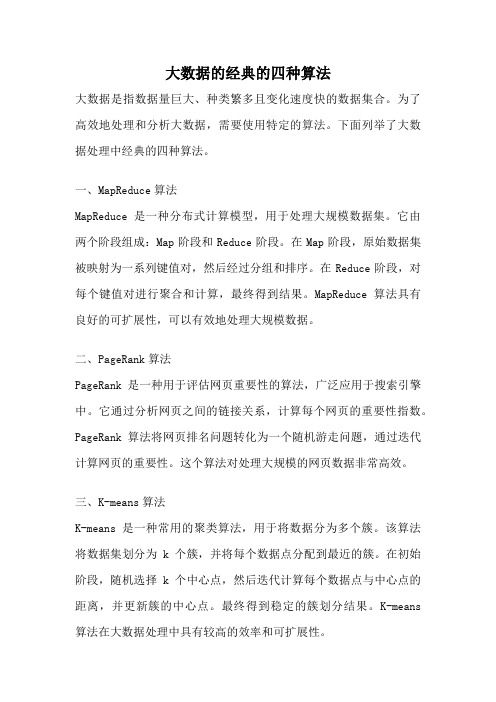
大数据的经典的四种算法大数据是指数据量巨大、种类繁多且变化速度快的数据集合。
为了高效地处理和分析大数据,需要使用特定的算法。
下面列举了大数据处理中经典的四种算法。
一、MapReduce算法MapReduce是一种分布式计算模型,用于处理大规模数据集。
它由两个阶段组成:Map阶段和Reduce阶段。
在Map阶段,原始数据集被映射为一系列键值对,然后经过分组和排序。
在Reduce阶段,对每个键值对进行聚合和计算,最终得到结果。
MapReduce算法具有良好的可扩展性,可以有效地处理大规模数据。
二、PageRank算法PageRank是一种用于评估网页重要性的算法,广泛应用于搜索引擎中。
它通过分析网页之间的链接关系,计算每个网页的重要性指数。
PageRank算法将网页排名问题转化为一个随机游走问题,通过迭代计算网页的重要性。
这个算法对处理大规模的网页数据非常高效。
三、K-means算法K-means是一种常用的聚类算法,用于将数据分为多个簇。
该算法将数据集划分为k个簇,并将每个数据点分配到最近的簇。
在初始阶段,随机选择k个中心点,然后迭代计算每个数据点与中心点的距离,并更新簇的中心点。
最终得到稳定的簇划分结果。
K-means 算法在大数据处理中具有较高的效率和可扩展性。
四、Apriori算法Apriori算法是一种用于挖掘关联规则的算法,常用于市场篮子分析等场景。
该算法通过扫描数据集,计算项集的支持度,并根据设定的最小支持度阈值,筛选出频繁项集。
然后,根据频繁项集构建关联规则,并计算规则的置信度。
Apriori算法通过迭代逐渐增加项集的大小,从而挖掘出频繁项集和关联规则。
以上四种算法在大数据处理中具有重要的作用。
MapReduce算法可用于分布式处理大规模数据;PageRank算法可用于评估网页的重要性;K-means算法可用于大规模数据的聚类分析;Apriori算法可用于挖掘大规模数据中的关联规则。
大数据的经典的四种算法
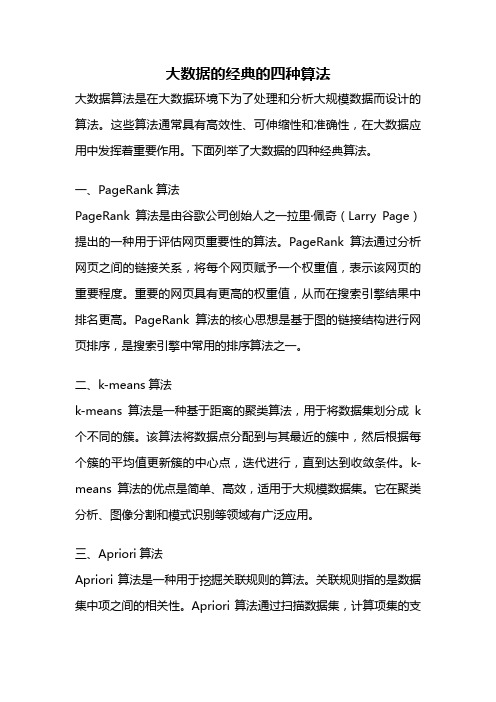
大数据的经典的四种算法大数据算法是在大数据环境下为了处理和分析大规模数据而设计的算法。
这些算法通常具有高效性、可伸缩性和准确性,在大数据应用中发挥着重要作用。
下面列举了大数据的四种经典算法。
一、PageRank算法PageRank算法是由谷歌公司创始人之一拉里·佩奇(Larry Page)提出的一种用于评估网页重要性的算法。
PageRank算法通过分析网页之间的链接关系,将每个网页赋予一个权重值,表示该网页的重要程度。
重要的网页具有更高的权重值,从而在搜索引擎结果中排名更高。
PageRank算法的核心思想是基于图的链接结构进行网页排序,是搜索引擎中常用的排序算法之一。
二、k-means算法k-means算法是一种基于距离的聚类算法,用于将数据集划分成k 个不同的簇。
该算法将数据点分配到与其最近的簇中,然后根据每个簇的平均值更新簇的中心点,迭代进行,直到达到收敛条件。
k-means算法的优点是简单、高效,适用于大规模数据集。
它在聚类分析、图像分割和模式识别等领域有广泛应用。
三、Apriori算法Apriori算法是一种用于挖掘关联规则的算法。
关联规则指的是数据集中项之间的相关性。
Apriori算法通过扫描数据集,计算项集的支持度和置信度,从而找到频繁项集和关联规则。
该算法的核心思想是通过逐层扩展频繁项集,从而减少搜索空间,提高算法效率。
Apriori算法在市场篮子分析、推荐系统和广告投放等领域有广泛应用。
四、随机森林算法随机森林算法是一种集成学习算法,通过构建多个决策树并集成它们的结果来进行分类或回归任务。
随机森林算法的核心思想是通过随机选择特征和样本,构建多个决策树,并通过投票或平均等方式集成它们的预测结果,从而提高模型的准确性和泛化能力。
随机森林算法具有较好的抗噪声能力和可解释性,广泛应用于数据挖掘、图像识别和自然语言处理等领域。
五、朴素贝叶斯算法朴素贝叶斯算法是一种基于贝叶斯定理和特征条件独立假设的分类算法。
大数据十大经典算法讲解
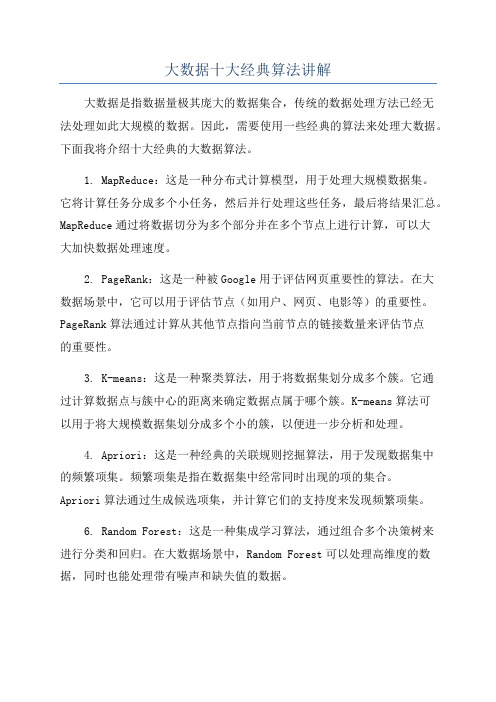
大数据十大经典算法讲解大数据是指数据量极其庞大的数据集合,传统的数据处理方法已经无法处理如此大规模的数据。
因此,需要使用一些经典的算法来处理大数据。
下面我将介绍十大经典的大数据算法。
1. MapReduce:这是一种分布式计算模型,用于处理大规模数据集。
它将计算任务分成多个小任务,然后并行处理这些任务,最后将结果汇总。
MapReduce通过将数据切分为多个部分并在多个节点上进行计算,可以大大加快数据处理速度。
2. PageRank:这是一种被Google用于评估网页重要性的算法。
在大数据场景中,它可以用于评估节点(如用户、网页、电影等)的重要性。
PageRank算法通过计算从其他节点指向当前节点的链接数量来评估节点的重要性。
3. K-means:这是一种聚类算法,用于将数据集划分成多个簇。
它通过计算数据点与簇中心的距离来确定数据点属于哪个簇。
K-means算法可以用于将大规模数据集划分成多个小的簇,以便进一步分析和处理。
4. Apriori:这是一种经典的关联规则挖掘算法,用于发现数据集中的频繁项集。
频繁项集是指在数据集中经常同时出现的项的集合。
Apriori算法通过生成候选项集,并计算它们的支持度来发现频繁项集。
6. Random Forest:这是一种集成学习算法,通过组合多个决策树来进行分类和回归。
在大数据场景中,Random Forest可以处理高维度的数据,同时也能处理带有噪声和缺失值的数据。
7. AdaBoost:这是一种提升算法,用于提高弱分类器的准确率。
在大数据场景中,AdaBoost可以通过迭代训练多个弱分类器,并根据它们的权重做出最终的分类决策。
8. Gradient Boosting:这是一种梯度提升算法,通过迭代训练多个弱分类器来提高整体模型的准确率。
在大数据场景中,GradientBoosting可以通过并行计算和分布式计算来加速模型训练过程。
9. Deep Learning:这是一种用于处理大规模数据的神经网络算法。
- 1、下载文档前请自行甄别文档内容的完整性,平台不提供额外的编辑、内容补充、找答案等附加服务。
- 2、"仅部分预览"的文档,不可在线预览部分如存在完整性等问题,可反馈申请退款(可完整预览的文档不适用该条件!)。
- 3、如文档侵犯您的权益,请联系客服反馈,我们会尽快为您处理(人工客服工作时间:9:00-18:30)。
Amazon y a = m 1 1 1
M’soft 1.00 0.60 1.40 0.84 0.60 1.56
y 7/15 7/15 1/15 a 7/15 1/15 1/15 m 1/15 7/15 13/15 0.776 0.536 . . . 1.688 7/11 5/11 21/11
I forget to divide by 3
Are all inlinks equal?
Recursive question!
Simple recursive formulation
Each link’s vote is proportional to the importance of its source page If page P with importance x has n outlinks, each link gets x/n votes Page P’s own importance is the sum of the votes on its inlinks
Matrix formulation
Matrix M has one row and one column for each web page Suppose page j has n outlinks
If j i, then Mij=1/n Else Mij=0
M is a column stochastic matrix
y a = m
M’soft
1/3 1/3 1/3 1/3 1/2 1/6 5/12 1/3 1/4 3/8 11/24 . . . 1/6 2/5 2/5 1/5
Random Walk Interpretation
Imagine a random web surfer
At any time t, surfer is on some page P At time t+1, the surfer follows an outlink from P uniformly at random Ends up on some page Q linked from P Process repeats indefinitely
Let p(t) be a vector whose ith component is the probability that the surfer is at page i at time t
p(t) is a probability distribution on pages
The stationary distribution
|x|1 = 1≤i≤N|xi| is the L1 norm Can use any other vector norm e.g., Euclidean
Power Iteration Example
Yahoo y a y 1/2 1/2 a 1/2 0 m 0 1/2 m 0 1 0
Amazon
Columns sum to 1
Suppose r is a vector with one entry per web page
ri is the importance score of page i Call it the rank vector | r| = 1
Example
Adapted from CS345 Data Mining
Link Analysis Algorithms Page Rank
Anand Rajaraman, Jeffrey D. Ullman
Link Analysis Algorithms
Page Rank Topic-Specific Page Rank Hubs and Authorities
Then p(t) is called a stationary distribution for the random walk
Our rank vector r satisfies r = Mr
So it is a stationary distribution for the random surfer
Spider traps
A group of pages is a spider trap if there are no links from within the group to outside the group
Random surfer gets trapped
Spider traps violate the conditions needed for the random walk theorem
Ranking web pages
Web pages are not equally “ims as votes
has 23,400 inlinks has 1 inlink
Microsoft becomes a spider trap
Yahoo y a y 1/2 1/2 a 1/2 0 m 0 1/2 M’soft y a = m m 0 0 1
Amazon
1 1 1
1 1/2 3/2
3/4 1/2 7/4
5/8 3/8 2
...
0 0 3
Random teleports (=0.8)
Existence and Uniqueness
A central result from the theory of random walks (aka Markov processes):
For graphs that satisfy certain conditions, the stationary distribution is unique and eventually will be reached no matter what the initial probability distribution at time t = 0.
Page Rank
Construct N by N matrix A as follows
Aij = Mij + (1-)/N
1/2 1/2 0 0.8 1/2 0 0 0 1/2 1 + 0.2 1/3 1/3 1/3 1/3 1/3 1/3 1/3 1/3 1/3
r = Mr
Amazon
M’soft y 1/2 1/2 0 y a = 1/2 0 1 a m 0 1/2 0 m
y = y /2 + a /2 a = y /2 + m m = a /2
Power Iteration method
Simple iterative scheme (aka relaxation) Suppose there are N web pages Initialize: r0 = [1/N,….,1/N]T Iterate: rk+1 = Mrk Stop when |rk+1 - rk|1 <
Suppose page j links to 3 pages, including i
j
i
= i
1/3
M
r
r
Verify that a column stochastic M preserves |r|.
Eigenvector formulation
The flow equations can be written r = Mr So the rank vector is an eigenvector of the stochastic web matrix
No unique solution All solutions equivalent modulo scale factor
Additional constraint forces uniqueness
y+a+m = 1 y = 2/5, a = 2/5, m = 1/5
Gaussian elimination method works for small examples, but we need a better method for large graphs
The Google solution for spider traps At each time step, the random surfer has two options:
With probability , follow a link at random With probability 1-, jump to some page uniformly at random Common values for are in the range 0.8 to 0.9
Simple “flow” model
The web in 1839
Yahoo y/2 y/2
y
y = y /2 + a /2 a = y /2 + m m = a /2
a/2
m Amazon
a a/2
M’soft
m
Solving the flow equations
3 equations, 3 unknowns, no constants
Where is the surfer at time t+1?
Follows a link uniformly at random p(t+1) = Mp(t)
Suppose the random walk reaches a state such that p(t+1) = Mp(t) = p(t)
